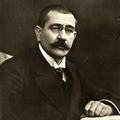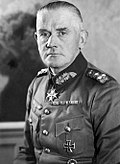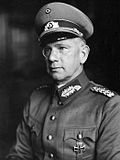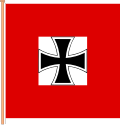Top Qs
Timeline
Chat
Perspective
Ministry of the Reichswehr
German interwar defence ministry From Wikipedia, the free encyclopedia
Remove ads
The Ministry of the Reichswehr (German: Reichswehrministerium) was the defence ministry of Germany from 1919 to 1938 during the Weimar Republic and early Nazi Germany periods. It was responsible for the Reichswehr under the leadership of the Minister of Defence and based in the Bendlerblock building in Berlin.
The Ministry of the Reichswehr was formed from the Prussian Ministry of War in the aftermath of World War I as part of a centralisation of the armed forces to Berlin from the states of Germany. Its longest serving Weimar-era Defence Ministers were the civilian Otto Gessler (almost 8 years) and General Wilhelm Groener (4 years). It was renamed the Reich Ministry of War in 1935 under the Nazis and led by General Werner von Blomberg as the Minister of War. It was abolished in 1938 and replaced with the Oberkommando der Wehrmacht (Armed Forces High Command) under the direct command of Adolf Hitler.
Remove ads
History
Summarize
Perspective
Formation
On 6 March 1919, the Weimar National Assembly – Germany's post-war interim parliament, which was tasked with passing necessary laws while it drafted a constitution for the Republic – enacted the Law on the Formation of a Provisional National Defence Force (Gesetz über die Bildung einer vorläufigen Reichswehr ). It authorized the president of Germany to:[1]
disband the existing Army and to form a provisional Reichswehr, which will protect the Reich's borders, enforce the orders of the Reich government and maintain peace and order within the Reich until the new Armed Forces (Wehrmacht ), which is to be organized by Reich law, is created.
The position of defence minister was established early in 1919[2] and filled by Gustav Noske on 13 February.[3] On 20 August, President Friedrich Ebert ordered that the Reichswehr Ministry take over from the federal states' war ministries on 1 October,[4] although it was not until 8 November 1919 that the new ministry was officially opened. The heads of Army Command (Heeresleitung ) and the Admiralty – which became Navy Command (Marineleitung ) on 15 July 1920 – were subordinate to the defence minister.[2] The Ministry was for the most part made up of members from the states' war ministries, with the majority coming from the Prussian Ministry of War.[5]
The Prussian armed forces remained under the command of General Walther Reinhardt, the Prussian Minister of War, until the Ministry was disbanded on 30 September 1919.[6] Reinhardt sat on the first two cabinets of the Weimar Republic as a non-voting member until 30 September, as did Admiral Adolf von Trotha in a similar capacity for the Admiralty until 27 March 1920, when the Bauer cabinet resigned.[3]
As a covert replacement for the German Empire's General Staff (OHL), which had been banned by the Treaty of Versailles (Article 160), the Truppenamt was formed within the Reichswehr Ministry in October 1919. General Hans von Seeckt was its first head.[7]
The Reich law to create a new Armed Forces, which had been referred to in the 1919 Law on the Formation of a Provisional National Defence Force, was promulgated as the Defence Act (Wehrgesetz ) on 23 March 1921 by the Weimar Reichstag. It formally established the Reichswehr in compliance with the limits set in the Treaty of Versailles. In § 8 [2], it stated that: "the Reich President is the supreme commander of the entire Armed Forces. Under him, the Armed Forces minister exercises command over the entire Armed Forces." Paragraph 10 also provided that:[8]
[1] An Army Board (Kammer ) and a Navy Board, whose members are elected by secret ballot, are to be established at the Reichswehr Ministry as advisory and expert bodies. [2] The Army and Navy Boards are directly subordinate to the defence minister.
In § 12, the war ministries of Bavaria, Saxony and Württemberg were dissolved, and command authority was concentrated in the hand of the defence minister.[8]
A Minister's Office (Ministeramt), which served as a top military authority between the minister and the army and navy leadership, was set up on 1 March 1929.[2]
Under the Third Reich
Just over two years after Adolf Hitler and the Nazi Party rose to power, the Proclamation of Military Sovereignty (Verkündung der Wehrhoheit ) of 16 March 1935 created a new Oberkommando der Luftwaffe (OKL) under the Air Ministry and turned the Heeresleitung into the Oberkommando des Heeres (OKH) and the Marineleitung into the Oberkommando der Marine (OKM). The Minister's Office was renamed the Wehrmacht Office.[9] The Defence Act (Wehrgesetz ) of 21 May 1935 made the Führer and chancellor (Hitler) supreme commander of the Wehrmacht. Under him, the renamed minister of war (Reichskriegsminister ) became commander-in-chief of the Wehrmacht (§ 3).[10]
As a result of the Blomberg–Fritsch affair,[11] Hitler took over as commander-in-chief of the Wehrmacht by decree on 4 February 1938. Under the same decree, the functions of the Ministry of War were taken over by the High Command of the Wehrmacht (Oberkommando der Wehrmacht, OKW). The Ministry of War ceased to exist at that point.[12]
Karl Dönitz was named as Minister of War in Hitler's testament.
Remove ads
Lists of officials
Defence ministers
- Flag of the Minister of Defence (1933–1935)
- Flag for the Minister of War and Commander-in-Chief of the Wehrmacht (23 June 1935 – 5 October 1935)
- Flag for the Minister of War and Commander-in-Chief of the Wehrmacht (5 October 1935 – 27 January 1938)
Ministerial office heads
Army heads
- Flag of the Chef der Heeresleitung from 1925–1927.
- Flag of the Chef der Heeresleitung from 1927–1933.
- Flag of the Chef der Heeresleitung from 1927–1933.
- Flag of the Oberbefehlshaber des Heeres from 1935–1941.
Navy heads
Remove ads
References
Notes
External links
Wikiwand - on
Seamless Wikipedia browsing. On steroids.
Remove ads





























